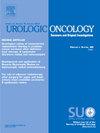Perioperative outcomes in testicular cancer patients treated with retroperitoneal lymph node dissection
IF 2.3
3区 医学
Q3 ONCOLOGY
Urologic Oncology-seminars and Original Investigations
Pub Date : 2025-06-29
DOI:10.1016/j.urolonc.2025.05.017
引用次数: 0
Abstract
Objective
No large-scale population-based studies quantified perioperative outcomes in testicular cancer (TC) patients treated with retroperitoneal lymph node dissection (RPLND), especially in non-metastatic and metastatic stages. Moreover, no previous studies compared outcomes in centers of excellence (Indiana University School of Medicine, Memorial Sloan Kettering Cancer Center, and MD Anderson Cancer Center) vs. large-scale population-based databases.
Methods
Using the National Inpatient Sample (2000–2015), we identified TC patients undergoing RPLND. Patient, tumor, and hospital characteristics were tested in two separate multivariable models addressing overall complications and length of hospital stay (LOS). Critical care therapy and in-hospital mortality rates were also quantified. All models were weighted and adjusted for clustering, as well as all available patient and hospital characteristics.
Results
In 1,988 non-metastatic patients overall complications were recorded in 469 (23.6%) vs. 758 (34.3%) in 2,213 metastatic RPLND patients. The rates of RPLND as well as the overall complications did not change during the study period. LOS increased by two days in both non-metastatic (4 vs. 6 days) and metastatic stages (5 vs. 7 days) in the presence of complications. In multivariable logistic regression models neither teaching hospital status nor hospital bed-size were predictors of overall complications.
Conclusion
RPLND patients should be informed about a 1:4 chance of overall complications in non-metastatic settings and of a 1:3 chance of overall complications in metastatic settings. Moreover, complication rates in population-based repertories are 2- to 4-fold higher than centers of excellence.
腹膜后淋巴结清扫术治疗睾丸癌患者围手术期疗效分析。
目的:没有大规模的基于人群的研究量化睾丸癌(TC)患者接受腹膜后淋巴结清扫(RPLND)治疗的围手术期结果,特别是在非转移期和转移期。此外,之前没有研究将卓越中心(印第安纳大学医学院、纪念斯隆凯特琳癌症中心和MD安德森癌症中心)的结果与大规模基于人群的数据库进行比较。方法:使用全国住院患者样本(2000-2015),我们确定了接受RPLND的TC患者。患者、肿瘤和医院特征在两个独立的多变量模型中进行测试,以解决总体并发症和住院时间(LOS)。重症监护治疗和住院死亡率也被量化。对所有模型进行加权和调整,以进行聚类,以及所有可用的患者和医院特征。结果:1988例非转移性RPLND患者中有469例(23.6%)对2213例转移性RPLND患者中有758例(34.3%)的总并发症。RPLND的发生率以及总体并发症在研究期间没有变化。在存在并发症的情况下,非转移期(4天vs. 6天)和转移期(5天vs. 7天)的LOS均增加了两天。在多变量logistic回归模型中,教学医院状况和医院床位大小都不是总并发症的预测因子。结论:应告知RPLND患者在非转移性情况下总并发症的发生率为1:4,在转移性情况下总并发症的发生率为1:3。此外,以人群为基础的储备的并发症发生率比卓越中心高2- 4倍。
本文章由计算机程序翻译,如有差异,请以英文原文为准。
求助全文
约1分钟内获得全文
求助全文
来源期刊
CiteScore
4.80
自引率
3.70%
发文量
297
审稿时长
7.6 weeks
期刊介绍:
Urologic Oncology: Seminars and Original Investigations is the official journal of the Society of Urologic Oncology. The journal publishes practical, timely, and relevant clinical and basic science research articles which address any aspect of urologic oncology. Each issue comprises original research, news and topics, survey articles providing short commentaries on other important articles in the urologic oncology literature, and reviews including an in-depth Seminar examining a specific clinical dilemma. The journal periodically publishes supplement issues devoted to areas of current interest to the urologic oncology community. Articles published are of interest to researchers and the clinicians involved in the practice of urologic oncology including urologists, oncologists, and radiologists.

 求助内容:
求助内容: 应助结果提醒方式:
应助结果提醒方式:


